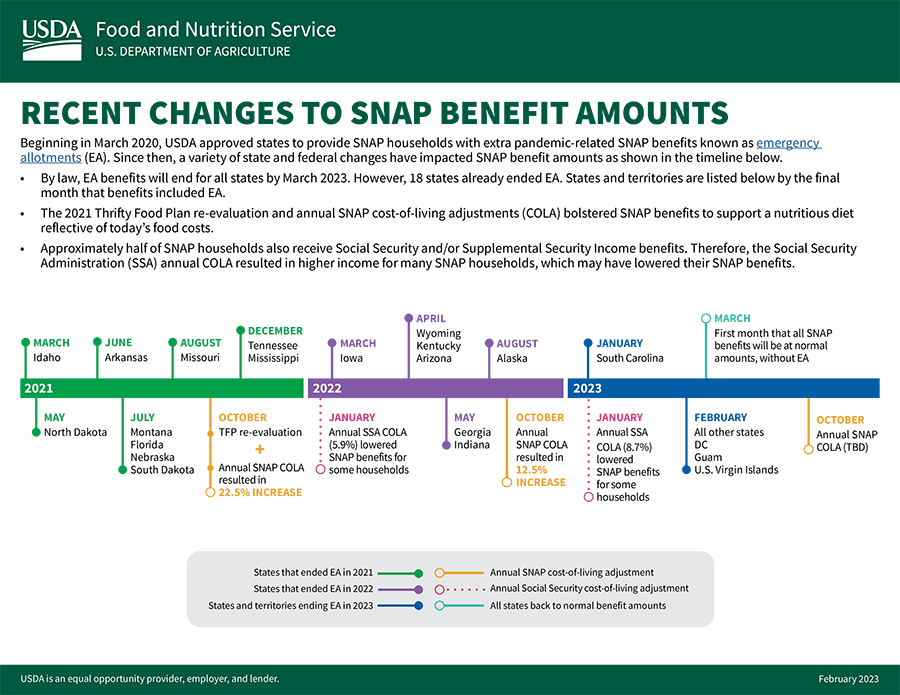Pronto, muchos hogares beneficiarios de SNAP experimentarán un cambio en los montos de sus beneficios. Esto se debe a que el aumento temporal relacionado con la pandemia a los beneficios de SNAP, conocido como asignaciones de emergencia (EA), está llegando a su fin .
Más de 41 millones de estadounidenses reciben beneficios para comprar alimentos a través de SNAP. Dependen de estos beneficios para poner comida en la mesa cada mes. Por eso es tan importante que sepan qué sucede con sus beneficios (y cuándo) para que puedan planificar para ellos y sus familias.
- En marzo de 2020, el Congreso aprobó una ley que permite al FNS proporcionar asignaciones de emergencia a todos los hogares SNAP para ayudarlos a superar las dificultades iniciales de la pandemia de COVID-19.
- A fines de diciembre de 2022, el Congreso aprobó otra ley que pone fin a la EA en todo el país después de su emisión en febrero de 2023.
- Como se muestra en esta infografía de la línea de tiempo, algunos estados ya dejaron de emitir EA: Alaska, Arizona, Arkansas, Florida, Georgia, Idaho, Indiana, Iowa, Kentucky, Mississippi, Missouri, Montana, Nebraska, Dakota del Norte, Carolina del Sur, Dakota del Sur, Tennessee y Wyoming. Los participantes de SNAP en estos estados ya volvieron a los montos de beneficios normales sin EA, por lo que la ley reciente no los afecta.
- En todos los demás estados y territorios, el aumento temporal de los beneficios finalizará después de febrero, lo que significa que los beneficios volverán a los montos normales a partir de marzo.
La reevaluación del Plan de Alimentos Económicos de 2021 y los ajustes anuales del costo de vida (COLA) del SNAP ayudan a garantizar que los beneficios del SNAP respalden una dieta nutritiva que refleje los costos de los alimentos actuales, pero el fin de los EA y el regreso a los montos normales de los beneficios del SNAP seguirán siendo un cambio sustancial para muchos hogares. Estamos trabajando en estrecha colaboración con todos nuestros socios federales, estatales y locales para asegurarnos de que los participantes del SNAP estén al tanto de los próximos cambios , para que no los tomen por sorpresa. Alentamos a todos los participantes del programa a asegurarse de que su información de contacto esté actualizada, para que su oficina local del SNAP pueda comunicar cualquier cambio futuro.
También alentamos a los hogares que reciben SNAP a que aprovechen otros programas de FNS para los que pueden ser elegibles y que pueden ayudarlos a satisfacer sus necesidades nutricionales generales. Por ejemplo, las personas elegibles pueden participar en SNAP y en el Programa Especial de Nutrición Suplementaria para Mujeres, Bebés y Niños, o WIC. WIC proporciona alimentos complementarios nutritivos, además de un beneficio en efectivo para frutas y verduras, así como educación nutricional y derivaciones a servicios sociales y de salud. FNS también brinda apoyo a través de comidas escolares, programas de comidas de verano, el Programa de Asistencia Alimentaria de Emergencia, el Programa de Nutrición del Mercado de Agricultores para Personas Mayores y más. Visite nuestro sitio web para obtener más información sobre los 15 programas de nutrición de FNS .
Cualquier hogar SNAP que busque información adicional sobre cómo
Estos cambios les afectarán y deben comunicarse con su oficina SNAP local .
Para obtener ayuda adicional, comuníquese con la línea directa contra el hambre del USDA .
La línea directa contra el hambre conecta a las personas que llaman con proveedores de alimentos de emergencia en su comunidad, programas de asistencia gubernamental y diversos servicios sociales.
1-866-3-HUNGRY (1-866-348-6479) o 1-877-8-HAMBRE (para español)
De lunes a viernes, de 7 a. m. a 10 p. m., hora del Este de EE. UU.
Versión en español
Puede encontrar la versión en español de este blog en el siguiente enlace: www.fns.usda.gov/es/blog/snap-emergency-allotments-are-ending


